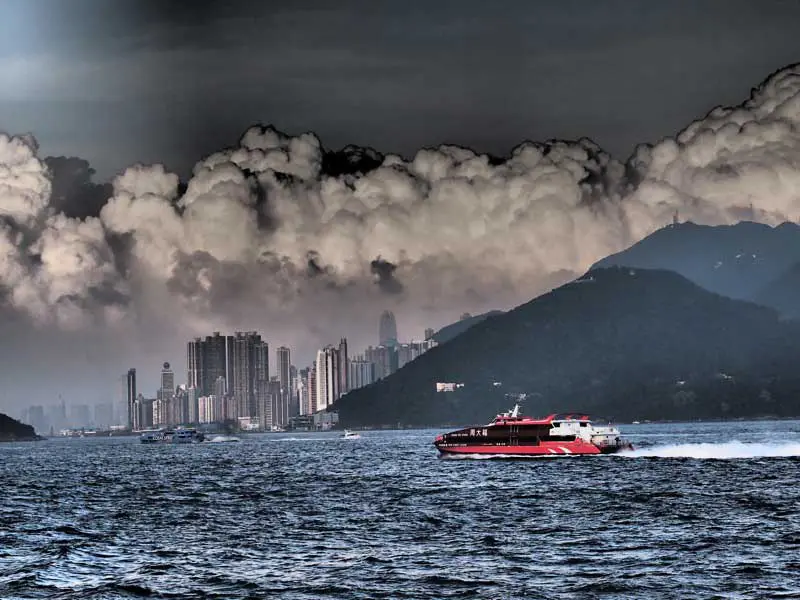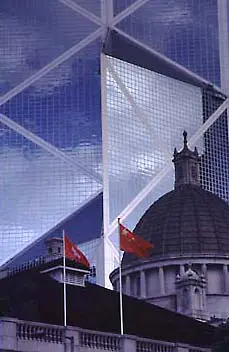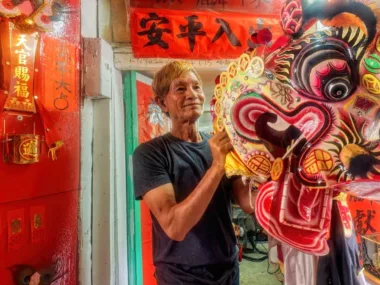From the great Kun Lun Shan range of central Asia, mountains push south to the coast, to the South China Sea. In one place, the mountains halt before a tongue of flat land, then dive below the sea, to emerge again as an island, an island the local fung shui men say is a dragon, turned to face its distant ancestor. Here, say the fung shui men, the mix of mountains, plain and sea forms a dragon’s lair; a place where the earth’s benevolent forces can concentrate. This place is Hong Kong.
Prosperous, quick to catch on to the latest electronic gadgets — be they fax machines or mobile phones — Hong Kong has held fast to ancient, esoteric beliefs which the mainland government has sought to dispel. Prominent among these is fung shui, or Chinese geomancy — professional practitioners can be found through a listing in the Yellow Pages.
Besides noting the swirl of cosmic forces on a grand scale, the geomancers include more mundane matters in their domain. They advise on location and shapes of buildings, auspicious dates for ceremonies, even arrangements of office furniture, or shapes and positions of beds. All factors which can, they say, affect health, harmony and — most importantly — prosperity.

To fung shui men (because of Confucian tradition — `Teach sons, not daughters’ — women rarely practice the art), the earth is a living organism; its breath is chi, the `dragon vapour’. Features in the landscape, and their orientation, are central to their work: the world’s first compass was invented in China not for navigation, but for geomancy. Hills may be regarded as phoenixes, turtles, dogs, or dragons — Kowloon means `Nine Dragons’, after the eight hills guarding it to the north, and a legendary emperor who arrived to search for the nine dragons, and threw himself in the sea when he counted only eight, not realising he was the ninth.
There are both good and bad locations for siting houses on hills; these may be based on sound practicalities. Ideally, a house should be on a south facing slope, flanked by arms of the hill — a situation which would ensure warming sun, shelter from the north winds that race through China in winter, and protection from floods. The dragon’s tail should be avoided, lest you anger the beast and it flick the house down — given that China is prone to earthquakes, this seems wise advice. A meandering river below will ensure wealth accumulates — there would likely be deposits of rich silt along its bank, helping make farming prosperous. Villages maintain fung shui woods beside them, on the uphill slope if they are on hillsides; these will protect from wind, and landslides.
`So,’ you may say, `fung shui is commonsense dressed up in the language of fairy tales.’ Well yes, in part. But it also includes esoteric practices: faltering marriages have improved after couples have repositioned beds on the advice of fung shui men; single men wanting to marry should sleep between pink sheets. The siting of graves has important consequences on descendants, who may prosper if the site has been well chosen (the best plots of lands are often expensive).
Fung shui has long baffled, and often hindered, westerners seeking to make `progress’ in China. `It is well known,’ wrote missionary John Arthur Turner, `that when telegraph poles were first put up in China, the people arose, tore them down and burnt them, on the plea that they spoilt the Fung Shui of the neighbourhood. But after the officials had taken off a few heads, the difficulty ceased, plainly showing that even superstition must give way to political necessity. Now, the people residing in country places content themselves with burning incense and making small offerings of fruit at the foot of the poles.’
Cash and unwanted ghosts
But that was last century. Today, cash, rather than taking off heads, is used by officials persuading villagers to accept developments which disturb the harmony of a place, the fung shui. To mitigate the harm caused by, say, putting up a new building, the villagers will hold a tan foo ceremony. A priest officiates, and may set up an altar, where he carries out a ceremony with paraphernalia including cups of wine, incense, a live chicken, and a book of incantations (an eyewitness of one ceremony wondered if the priest understood the book, which was dated 1886-1887; another remarked the priest `gave the impression great and mysterious things were happening’). In case the gods and spirits are not fully satisfied, another ceremony may follow in a couple of years, to renew the charms.
While cash usually wins over the villagers — after some bargaining (`Can’t be moved’, `HK$1000′, `Can’t be moved’, `HK$1500′ … `HK$1700′, `Done’) — they can remain resolute. A recent row centred on the development of a repository for human ashes. With financial inducements rejected, elderly women from the district vowed the villagers would fight a `fung shui war’ against the development, saying seven people had already died because of work in progress, and it threatened the younger generation. Said one 82-year old: `We don’t want these ghosts.’
Human ghosts are not the only spirits inhabiting the supernatural Chinese landscape. Even rocks have spirits; some are worshipped as Earth Gods, charged with looking after the neighbourhood. Tree spirits are also worshipped, the most popular being the spirit residing in the long-lived banyan, credited with the power to heal the sick. The prosperity of Cheung Chau, island home of fishing community and commuters, is said to be mainly the effect of a centrally located, elderly banyan; some people take this tree as godfather of their children, hoping they will grow up smart and strong.
A 500-year old banyan is perhaps the world’s costliest tree. It was threatened by construction of a shopping and office complex, and the developer, Swires, was required to preserve it. Doing so, according to Swire Pacific Limited chairman D. Gledhill, `involved the building of the biggest concrete flower pot in the world at a cost of some HK$24 million.’
Examples of fung shui in the city abound. Though Central, the business district, is now sited to the satisfaction of fung shui men, the original commercial centre founded by the British was in an inauspicious, inaptly named locality, Happy Valley. The fung shui was made even worse by the construction of roads and buildings; a contemporary of Reverend Turner wrote that when a road was cut from Happy Valley, `the terror of the Chinese was very great, and when malaria carried off labourers in large numbers, this was thought to be caused by Fung Shui’. After Chinese boycotted the centre, it was relocated to Central.
Central is auspicious because it lies on a dragon’s vein, which runs down to the sea from Victoria Peak. Among the buildings located on the vein is the headquarters of the Hong Kong and Shanghai Bank. Besides its situation, the bank has good fung shui because of its shape: demonstrating it is not only hills that inspire imagination, a geomancer has likened the building to a laughing Buddha. Its view of the waters of Victoria Harbour is also important, symbolising the inflow of money. So important that the bank gave the government money to build a park and low-lying garage to ensure the harbour view would be unobstructed.
Fung shui and the city


Nearby, and also on the vein, is the Bank of China. Despite its situation, and a topping out ceremony held on 8.8.88 (a highly auspicious date; bhat, the Cantonese for eight, sounds like the word for prosperity), this building has come under fire from fung shui experts. The design, based on triangles, is not favoured because a triangle resembles a pyramid and kam te chap, the Cantonese phrase for pyramid, is similar to kam chap — the urns used for keeping the remains of the dead. Further, say the experts, the sharp corners are like daggers: some appear to point inwards, while one points at Hong Kong’s Legislative Council Building, and another at Government House (British writer Simon Winchester likened the bank to `a dagger aimed at the heart of British rule’). Then, the two `chopsticks’ on top of the building point upwards, like incense sticks used as a memorial to the dead.
While the Bank of China is said to both radiate and self-inflict bad fung shui, the Hang Seng Bank headquarters was facing purely internal problems as it neared completion in 1989. According to the experts, a footbridge directly in front of the main entrance represented a dagger pointing at the heart. Plans were drawn up for two new footbridges, to be built at a cost of HK$10-20 million. Though the bank’s assistant manager of public relations said the bridge was being replaced for `no particular reason’, the senior architect told the press it was partly to improve the fung shui.
Not only banks take fung shui into account. Across the harbour from Hong Kong Island, the Regent hotel has been built at the spot where the Kowloon dragons come down to bathe. To ensure they can still reach the water, the lobby has floor-to-ceiling glass.
Even that most British of buildings, the Governor’s House, is auspiciously located and oriented, leading to suspicions that fung shui experts were consulted when it was planned. It does, though, now lie in the path of the bad fung shui radiating from the Bank of China. So too does the nearby American Consulate, where staff have reportedly taken countermeasures–putting up small, hexagonal mirrors to return the ill fortune whence it came. (This seems ironic, since the consulate was itself regarded as a source of bad fung shui: its windows were reflecting bad influences to the nearby Hong Kong Legal Deparment, where clerks had installed mirrors to reflect them right back.) If the Governor has taken similar action against the Bank of China, no one is saying.
Hexagonal, bhat gwa mirrors are the commonest recourse of individuals believing themselves threatened by bad fung shui. But besides repelling malevolent influences and demons (which flee when they see their hideous reflections), mirrors can also draw in positive forces: if an office overlooks the a lake, river or (as so often in Hong Kong) the sea, a mirror can reflect the water’s chi, which draws in money. Hong Kong offices without a sea view often introduce their own water — fish tanks serve not merely for decoration, but as business aids.
If these do-it-yourself efforts do not work, and an office, or home, experiences continuing ill fortune, a fung shui man may be called in. His advice will likely include the proper use and siting of mirrors and fish tanks, more auspicious arrangements of furniture, better colour schemes, or even, if the situation appears really bad, relocating (much as, in rural areas, some villages have been abandoned on the grounds of bad fung shui).
Though few people in Hong Kong fervently believe in fung shui — some locals scoff at the dragon veins, mirrors and so on — most at least pay lip service to it, just in case. Even some westerners become converts. During his stint as Secretary for District Administration, Sir David Akers-Jones called in a fung shui expert to advise on the layout of furniture in his office; among the recommendations he accepted was a screen to `shield against inauspicious things’.
Western companies setting up in Hong Kong may also adopt strategies for good fung shui. A branch of the British department store Marks and Spencers has strategically placed lights, wooden turtles, and fish tanks. And in north Kowloon, a McDonald’s outlet followed a fung shui man’s advice by introducing a feature sure to attract attention, whatever its impact on revenue: a tank of piranha fish.
[This article appeared in the July 1992 issue of Far East Traveler.]
March 2023, quick update: an art installation now supposedly upsetting fung shui masters here. Whether bad joss or no, does look ugly in photo here I reckon:
Hong Kong Travel
Demolition Looms for Last Villages Below Lion Rock
Walking into the old part of Ngau Chi Wan Village, I’m soon on a path between two-storey buildings, which include a…
Hong Kong Nightlife – bars n discos
A Hong Kong tour for night owls, including the Peak, Kowloon, Lan Kwai Fong, and Wanchai.
Hong Kong Hiking on islands and across the New Territories
An overview of hiking in Hong Kong, including a pick of the best trails and areas.
Cheung Chau, Hong Kong: a downright quirky island so near yet apart from the city
What other place do you know where the chief annual festival involves feeding ghosts, then banishing them to the underworld?
Lantau Island, Hong Kong: temples, hiking trails, interesting old forts
Hong Kong’s largest and most beautiful island: Lantau (爛頭)
Many Splendoured Hong Kong
Hong Kong has much to offer, including beaches, trails, villages, islands, and the city itself
Peninsula Hotel Hong Kong
The host of celebrities who have stayed at Hong Kong’s Peninsula Hotel include Noel Coward, the quintessential British wit who penned…
New Territories Hiking, Hong Kong
Rural Hong Kong is as compact and varied as its urban counterpart, with a host of marvellous places to visit, and…








